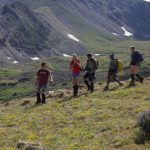Summer Term 2016: “Moments of joy are everywhere”
 Our feet were gradually turning white as we stood in the Arkansas River, picking our way carefully through the rushing stream and the slick rocks beneath the water. As we had learned in our Sense of Place science class, this stream came straight from alpine snowmelt; we could feel it. Cold water bit at our ankles as we tried to concentrate on the tasks at hand. Nevertheless, our lab group members waded intrepidly across, measuring the width, depth, and velocity of the river. Meanwhile, two other members of our group scooped out bugs—or macroinvertebrates—from the river, sat down in the long grasses on the riverbank, and with a great measure of meticulousness, sorted the bugs by specie and counted them. Who knew that splashing around in rivers and counting bugs could be used to investigate the effects of climate change in the Arkansas River Valley? As we learned in science class, both stream flow and macroinvertebrate population fluctuate in response to temperature changes. Therefore, we could study these two factors in order to understand how our corner of the world was affected by climate change. Outdoors by the riverside, that study felt more like a sort of play. Capturing, organizing, and counting bugs proved to be a very neat challenge, and we even named our own bug in HMI’s honor after no one could identify it.
Our feet were gradually turning white as we stood in the Arkansas River, picking our way carefully through the rushing stream and the slick rocks beneath the water. As we had learned in our Sense of Place science class, this stream came straight from alpine snowmelt; we could feel it. Cold water bit at our ankles as we tried to concentrate on the tasks at hand. Nevertheless, our lab group members waded intrepidly across, measuring the width, depth, and velocity of the river. Meanwhile, two other members of our group scooped out bugs—or macroinvertebrates—from the river, sat down in the long grasses on the riverbank, and with a great measure of meticulousness, sorted the bugs by specie and counted them. Who knew that splashing around in rivers and counting bugs could be used to investigate the effects of climate change in the Arkansas River Valley? As we learned in science class, both stream flow and macroinvertebrate population fluctuate in response to temperature changes. Therefore, we could study these two factors in order to understand how our corner of the world was affected by climate change. Outdoors by the riverside, that study felt more like a sort of play. Capturing, organizing, and counting bugs proved to be a very neat challenge, and we even named our own bug in HMI’s honor after no one could identify it.
While learning about Leadville’s natural environment in science class, we sought to further the development of our sense of place by interviewing locals during humanities class. Our assignment emulated the “Humans of New York” project, an art blog that interviews and photographs seemingly random New Yorkers. The project aims to show what a true New Yorker looks like and to strengthen the idea that everyone we pass on a street has his or her own story. Looking to learn more about Leadville, we split into small groups to interview Leadville locals for our very own “Humans of Leadville” project. Unleashed on the town, we spent an afternoon interviewing people in our favorite stores and on the street. One group created an interpretative video journal to bring more emotion into the project and got some great quotes such as “Leadville was never just a town, it has always been a place.”
sense of place by interviewing locals during humanities class. Our assignment emulated the “Humans of New York” project, an art blog that interviews and photographs seemingly random New Yorkers. The project aims to show what a true New Yorker looks like and to strengthen the idea that everyone we pass on a street has his or her own story. Looking to learn more about Leadville, we split into small groups to interview Leadville locals for our very own “Humans of Leadville” project. Unleashed on the town, we spent an afternoon interviewing people in our favorite stores and on the street. One group created an interpretative video journal to bring more emotion into the project and got some great quotes such as “Leadville was never just a town, it has always been a place.”
When not in class, faculty members Dylan, Peter, and Leslie taught a group of students how to fly fish. Everyone was challenged at first by assembling the rod, tying the fly, and perfecting the cast, so we spent the whole first day learning. To improve the aim of our casts, we attempted to hit rubber ducks off of the top of water bottles or have our fly land inside a hula-hoop. Many people were a frustrated on our first day at the lake because they seemed to be catching more trees than fish, but a few students succeeded and caught several small fish! On our last day of fishing, we hiked about two miles to Timberline Lake, a beautiful alpine lacked tucked into the mountains. A few people caught fish and it was a relaxing day, making everyone excited to fish in the backcountry on second expedition.
While clinging to a rock face several feet above the ground, or running four miles at 7 AM, or furiously typing up lab reports, or chatting up local Leadvilleans, many realized that the HMIcampus experience kept defying how they viewed life in the classroom. The classroom has expanded to include the Rocky Mountains, nearby rivers and forests, Leadville, and the trails and woods around HMI. After rock climbing, we all gathered on a group of large boulders for Practices and Principles class and learned about decision-making styles. Mountainsides of evergreen trees made up the backdrop. Learning is more than just academics, though we’ve done plenty of that, too. We’ve learned about our Myers-Briggs Type Indicator personality types, helping shed light onto how we view the world and function within it. We’ve learned how to fly fish and rock climb, several of us for the first time. We’ve gotten to know Leadville through interviewing and gathering the stories of native Leadvilleans. We’ve pushed ourselves physically in our daily morning exercise and other self-imposed long runs, running farther than we ever thought we could before. We’ve continued to develop relationships with our peers, as well as the Vail Mountain School students we’re lucky to share our time on campus with. Though we have supposedly settled into to the rhythm of life back on campus, experiences that challenge us and help us grow are still ever-present. And hopefully that growth will continue into the backcountry as we leave for our second expedition.
 Beyond thinking forward to second expedition, there is plenty to be enjoyed in the present moment. Drying warm dishes while on cook crew, dipping our feet in the stream that runs through the HMI campus, spending time with our peers, hanging up clothes to dry on the line, playing silly games, relishing French toast: moments of joy are everywhere. Take, for instance, this very afternoon, bicycling down County Road 5A, peers in front, mountains on either side, blue sky and bright sun above. As we sped down the road, we kept remarking how lucky we were to be in this beautiful place, learning about all sorts of things, and experiencing it with this group of people. Maybe it was just the speed, but a lightness took over, an elation that hadn’t been sensed in a while, and we flew light on the bicycles, all the way back to HMI.
Beyond thinking forward to second expedition, there is plenty to be enjoyed in the present moment. Drying warm dishes while on cook crew, dipping our feet in the stream that runs through the HMI campus, spending time with our peers, hanging up clothes to dry on the line, playing silly games, relishing French toast: moments of joy are everywhere. Take, for instance, this very afternoon, bicycling down County Road 5A, peers in front, mountains on either side, blue sky and bright sun above. As we sped down the road, we kept remarking how lucky we were to be in this beautiful place, learning about all sorts of things, and experiencing it with this group of people. Maybe it was just the speed, but a lightness took over, an elation that hadn’t been sensed in a while, and we flew light on the bicycles, all the way back to HMI.


 Summer Term 2016: “Loving a summer spent here in Leadville!”
Summer Term 2016: “Loving a summer spent here in Leadville!”
 Summer Term 2016: 2nd Expedition
Summer Term 2016: 2nd Expedition